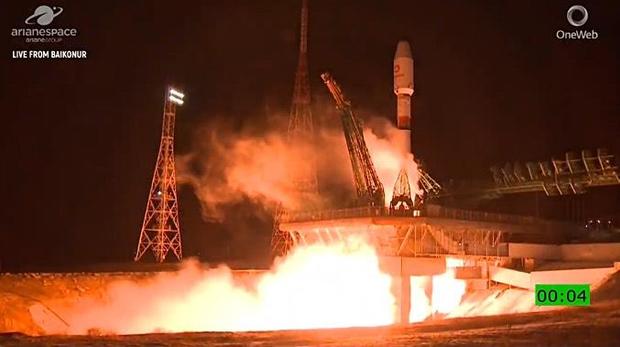OneWeb launches 34 satellites as race to provide space-based internet service heats up
A Russian Soyuz rocket boosted 34 OneWeb internet satellites into orbit Thursday, the second and largest batch of broadband beacons in a commercial constellation requiring 650 small, mass-produced data relay stations to provide high-speed internet services around the world.
OneWeb launched its first six satellites in February 2019. The latest batch, built by OneWeb Satellites, a joint venture between OnWeb and Airbus Defense and Space, is part of a push to ramp up mass production at a new factory just outside the Kennedy Space Center in Florida. The goal is to prepare more than 30 new satellites a month for launch.
"This is a very significant launch for us, and I think this launch and really the next launch are critical because it will show the success that we've had with OneWeb Satellites ... getting the assembly line approach actually working," said OneWeb CEO Adrian Steckel. "The real proof will be when we have 34 satellites for Launch No. 3 ready by Feb. 17 or so."
The current mission began at 4:42 p.m. EST (2:42 a.m Friday local time) with a sky-lighting liftoff from the Baikonur Cosmodrome in Kazakhstan, the first of as many as 20 launches managed by Arianespace over the next two years, each one carrying 32 to 36 satellites.
Trailing a long jet of brilliant flame, the Soyuz-2.1b rocket shot away to the north through a cold night sky, reaching an initial orbit about 14 minutes after launch. The rocket's Fregat upper stage fired again a little more than an hour after launch to put the spacecraft into a 280-mile-high circular orbit around Earth's poles.
After deploying two 325-pound OneWeb satellites, the Fregat released the remaining 32, four satellites at a time in between subsequent engine firings, over the course of several hours.
If all goes as planned, London-based OneWeb will have enough satellites in orbit to begin delivering limited commercial service later this year. Global service is planned in 2021.
"OneWeb is doing for the satellite industry what Henry Ford did for cars," FCC Chairman Ajit Pai said when OneWeb's Florida factory opened last year. "This technology holds special promise for bringing high-speed broadband service to those in rural and tribal and remote parts of the country, parts of the world, people who've never been connected before."
In a competing venture, SpaceX already has launched 240 of its Starlink internet satellites atop four Falcon 9 rockets and plans to have more than 700 relay stations in orbit by mid-year, enough to begin limited commercial service in North America and Canada. The company has regulatory approval to launch more than 12,000 Starlinks, in multiple orbital planes, to provide seamless global service.
OneWeb plans an initial constellation of 588 satellites with up to 60 orbital spares. Depending on demand, the company eventually could deploy nearly 2,000. Because the OneWeb satellites operate in a higher orbit than the SpaceX Starlinks, fewer relay stations are needed to provide global service.
"Our satellites are at 1,200 kilometers (745 miles), theirs are at 550 (340 miles)," Steckel said at a pre-launch briefing. "That's just geometry. Our satellites have a bigger field-of-view. Their system doesn't give them global coverage, even though they have a lot more satellites, because they're lower and they do not (initially) have inter-satellite links.
"Because ours are higher and we have big ground stations, we're able to sort of reach over the horizon and guarantee ... global coverage. We have filings for thousands of satellites ... and they have for tens of thousands of satellites."
SpaceX does, in fact, plan to launch downstream satellites with inter-satellite links enabling the relay stations to hand off internet traffic from one satellite to another as they streak overhead and pass by ground terminals.
"That is fundamental to the structure of their system, and that is not something that's acceptable to governments who want to make sure that they have the ability to exercise sovereignty over the Internet," Steckel said. "It's a different business plan. Nothing in what I'm saying is a criticism of them. They could be highly successfully. We're playing a different ball game (with) similar technology."
One issue both companies are facing is concern among astronomers that hundreds, not to mention thousands, of satellites in low-Earth orbit will pose a threat to deep space observations by the world's largest optical telescopes. Data transmissions from the satellites also pose a threat to sensitive radio telescopes.
One of the Starlinks launched by SpaceX late last year featured a dark coating intended to lower its reflectivity and make it less visible to even large telescopes. That satellite isn't in its operational orbit yet and it isn't known how effective the coating might be.
OneWeb managers also acknowledge the issue but say their satellites, operating in higher orbits, won't not be as bright. But that doesn't mean invisible.
"We're going to do the most we can to mitigate," Steckel said. "We're not visible to the naked eye. We are visible to telescopes. It's hard to get around some of those facts. With respect to radio frequency ... we'll try. We're going to do the most we can. I don't know if there will be a solution that will make everybody happy (but) at least we're in dialog. We're trying to get feedback on what can we do."






